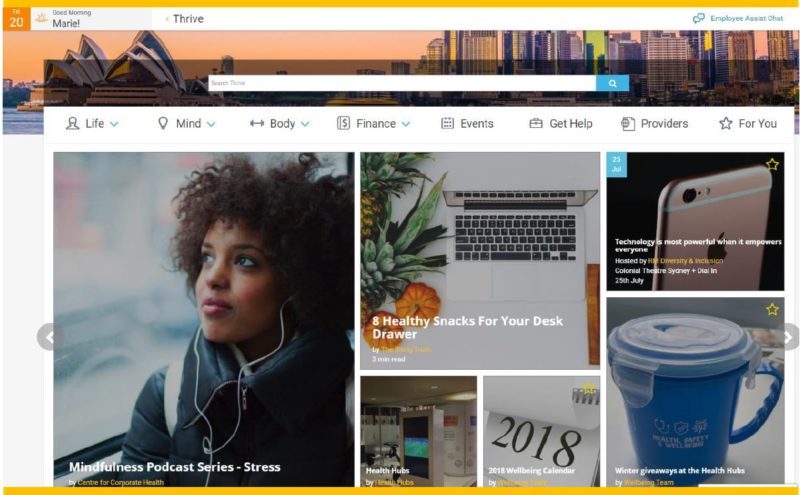Heather Beach, from the Health Work Company, explores her findings on health and wellbeing in Australia, following a month’s stay on the other side of the world.
When I blithely decided to spend the whole of August in Australia to show my daughter her birthplace, I didn’t bank on the guilt which would assail me every now and then. A guilt deep rooted in an upbringing bound by a strong work ethic and which, like most strengths, can also be a weakness. However, the perfect remedy was to do a few work-related meetings whilst in Sydney, and relax the rest of the time. I was lucky enough to get some introductions when I asked for ‘people doing interesting things in health, safety and wellbeing’ the first being to Ben Sheidow, Head of Health, Safety and Wellbeing for the Commonwealth Bank of Australia (CBA).
Wellbeing statistics
 In a country full of sunshine and smiles, a seeming addiction to outdoor sports, the Aussie pie not reaching below the latte line (which blazes the vanguard in excellent nutrition including an explosion of juice bars, acai bowls, kombucha and kefir), what exactly does Australia have to do with poor wellbeing? However, with the WHO saying that depression will be the leading cause of disability worldwide by 2020, it isn’t so surprising that poor mental health – particularly the rise in anxiety – has hit Australia too. According to the latest estimates from the World Health Organization (WHO), 1.3 million Australians (5.9% of the population) are experiencing a depressive disorder which is the same rate as that of the United States. Meanwhile 1.6 million Australians (7% of the population) are experiencing an anxiety disorder.
In a country full of sunshine and smiles, a seeming addiction to outdoor sports, the Aussie pie not reaching below the latte line (which blazes the vanguard in excellent nutrition including an explosion of juice bars, acai bowls, kombucha and kefir), what exactly does Australia have to do with poor wellbeing? However, with the WHO saying that depression will be the leading cause of disability worldwide by 2020, it isn’t so surprising that poor mental health – particularly the rise in anxiety – has hit Australia too. According to the latest estimates from the World Health Organization (WHO), 1.3 million Australians (5.9% of the population) are experiencing a depressive disorder which is the same rate as that of the United States. Meanwhile 1.6 million Australians (7% of the population) are experiencing an anxiety disorder.
One of my Sydney-based friends has a burgeoning practise in addiction therapy and another a Child Psychology business which, established over five years ago, now sees a number of copy cats.
With not such a dissimilar picture to the UK after all, I suspected however, that there might be aspects of the understanding of corporate wellbeing and mental health agenda which may be ahead of the UK. Mental Health First Aid was, after all, founded in Australia seven or so years before being transported to our shores and other innovation in health and safety such as Safety Differently were also started and tested first here. However, I was unprepared for just how far a much more holistic version of wellbeing had permeated some of corporate culture.
Yes, there are plenty of companies who don’t invest in wellbeing in Australia, and where bad management is endemic (one friend told me of her manager’s refusal to allow her to leave work half an hour early for a funeral), but where the focus is there, it has reached much further than that of the UK. That is, if you agree with my description as the UK having moved from a definition of wellbeing based purely on physical health, to an interim step which looks at basic education in mental health and how to intervene with someone struggling (MHFA) but which in too few cases looks at root causes of stress in the workplace or prevention.
In spite of a comprehensive review into conduct at Australia’s banks and financial institutions, called the Royal Commission, which the UK has already undergone, the bank is continuing to invest more in the wellbeing of its people – and is even extending some of its services to customers.
With over 49,000 employees and 1,500+ locations around the world, Ben’s team is organised by skillset with, for example, a governance team looking at board reporting, a delivery team organising initiatives, a health and wellbeing team and one looking after systems and projects. It also includes a Chief Medical Adviser (or CMA) an approach which is not widespread.
The health, safety and wellbeing team are part of the ‘people’ function within the bank – and sit inside HR. This seems a more typical set up in Australia than it is in the UK (although others described wellbeing as a ‘bunfight’ between HR and health and safety) and is probably particularly appropriate to a bank where a large proportion of the risks are going to be people interacting with people.
 In a textbook approach to health and safety risks, the team’s focus is about designing them out – so coin handling for example, which was causing manual handling injuries has led them to design a new system to manage smaller loads. This means that the health and safety delivery team don’t need to invest in training in the way they would otherwise have to and for many, it feels that health and safety is almost invisible – they don’t feel it being ‘done’ to them. Work driving risks are countered by giving employees a limited choice of the safest cars available.
In a textbook approach to health and safety risks, the team’s focus is about designing them out – so coin handling for example, which was causing manual handling injuries has led them to design a new system to manage smaller loads. This means that the health and safety delivery team don’t need to invest in training in the way they would otherwise have to and for many, it feels that health and safety is almost invisible – they don’t feel it being ‘done’ to them. Work driving risks are countered by giving employees a limited choice of the safest cars available.
With customer aggression on the rise across many industries, including financial services, part of the health and safety team’s responsibilities is to look at root causes of this to understand how the customer journey can be as painless as possible. A recent initiative has also provided a free support service for customers, similar to what is available for employees to call who have any issue which is causing them upset or frustration. For example, a customer comes into a local branch disclosing some distressing personal details, they can be taken into a private room and connected with a counsellor to help work through some of the issues and refer on as appropriate.
Improving wellbeing in Australia
Transferring the ‘design out risk’ approach to mental health and wellbeing
Seven or eight years ago, when the initiative first started, data was primarily used by mining what was available from the available sources such as incidents and claims to look at where to target investment and education. The work environment was a huge area of focus and finally an approach to mental health was adopted which was aimed to demystify, increase awareness and educate through training.
Work environment is still an area of pride for the bank with CBA’s with main office buildings including an integrated health hub. These hubs do not just include health kiosks (13,500 people have however gone through the basic health check with 190 people referred for urgent treatment) but also access to a specialist one on one education and support around all aspects of wellbeing from emotional resilience coaching, mindfulness, food intolerances, spinal health, hypnotherapy and financial planning, to nutrition, fitness and sleep.
Two-three years ago the approach was reviewed and considered over all successful as a baseline, but, a more holistic strategy was built which focused on all stakeholders – managers, employees and customers and which looked at an approach to ill health in terms of:
- Prevention;
- Intervention;
- Recovery.
ith 1,500 locations and over 49,000 highly diverse individuals to support – all with their own issues and ways of operating – a mostly online solution needed to be found. Thus the Thrive portal was born.

Thrive
Thrive is a personalised portal covering life, mind, body and finance and is aimed at employees and managers. The content is produced using over 20 different subject matter experts and it can be utilised to create an action plan for your own health, book in for a live event or a pop-up session (there is even pop-up knitting!), read an article or watch one of a range of videos aimed at either managers or all employees. The most popular are the 21 employee stories of recovery from issues such as cancer or post-natal depression, significant weight loss and overcoming chronic illness. My favourite video used actors and was aimed at managers to look at the subtle differences between an empowering, supportive conversation and one which just leaves the employee more anxious about the issue they came to you with. I liked this because the ‘how not to do it’ really wasn’t that bad – it was probably the way most of us would react without the appropriate training and it really showed the subtleties which make a huge difference in any conversation about work or personal life.
Live for 20 months, the platform has had double the usage anticipated with 36,000 unique users, for and over 300,000 views.
Other key aspects of the programme
Face-to-face training is also utilised for managers – who have mandatory training which includes mental health and a group of volunteers called ‘thrive champions’ who are there to listen, support and act as examples.
Ben is also keen to point out that the continued collection of data is important and that for someone to report an incident needs to be easy. Health and safety law in Australia includes bullying and harassment at work and therefore all incidents get logged through an app and there is an escalation process involved. Pre-employment questionnaires are utilised which also ask about mental health to establish what if anything is needed to support a new employee to best set them up for success, and importantly, they have a well utilised flexible working programme called ‘I Can Flex’ and with excellent IT solutions, many people can work from anywhere.
Stress risk assessment
Health and safety law in Australia, whilst currently bedding in industrial manslaughter in some jurisdictions (led by the UK) and with some very high penalties in certain states (up to $20m in QLD for example) is extending regulatory and inspectorate oversight to psychological health. This includes building a psychological health inspectorate in some jurisdictions. Many companies who undertake a risk assessment for stress use the Canadian standards which are based on the UK’s but add some further areas of focus for example – career. CBA also benchmarks against these standards to continue to identify ways to improve the approach to psychological health.
Change driver?

Ben Sheidow
I was interested to know more about why some companies in Australia are potentially ahead of those in the UK when it comes to looking at mental health specifically – and I will be interested in reader’s perspectives on this – because whatever levers have proved successful within a business environment, there may be lessons to be learnt for the UK. With stress being the leading cause of days off for ill health, there is obviously a commercial driver to improve – but that is no different to the situation in the UK. Perhaps the MHFA movement having started in 2,000 may have made a difference? Perhaps the decision for some companies to put health and safety inside the people function may provide greater alignment and focus between HR and health and safety – which is certainly required for a holistic, root cause approach to the management of stress? Or is it, as some of my meetings suggested, driven by insurance? With different approaches taken by companies in terms of the payment of sick leave for stress – with some self-insuring, some using the more traditional routes of insurance covering pay and others choosing the salary continuance option, there is no doubt that covering sick leave can be expensive.
Ben Sheidow reminds us that non-work-related mental health conditions are more prevalent than work-related mental health conditions: “Through our Prevention/Intervention/Recovery model, we look at both work and non-work-related matters. Ultimately if someone is off work they are unable to be productive or effective at work or in their personal life, the best outcome is that a person is physically and psychologically healthy for all aspects of their life as we know peoples work and personal lives are so closely linked”.
With anxiety in both Australia and the UK continuing to increase, the same societal focus on mental health, the rise of loneliness, the difficulties of work-life balance and a renewed understanding of the importance of sleep, it appears that in spite of the sunshine and access to the ‘good life’ we are both on this journey together.
What makes us susceptible to burnout?
In this episode of the Safety & Health Podcast, ‘Burnout, stress and being human’, Heather Beach is joined by Stacy Thomson to discuss burnout, perfectionism and how to deal with burnout as an individual, as management and as an organisation.
We provide an insight on how to tackle burnout and why mental health is such a taboo subject, particularly in the workplace.

 In a country full of sunshine and smiles, a seeming addiction to outdoor sports, the Aussie pie not reaching below the latte line (which blazes the vanguard in excellent nutrition including an explosion of juice bars, acai bowls, kombucha and kefir), what exactly does Australia have to do with poor wellbeing? However, with the WHO saying that depression will be the leading cause of disability worldwide by 2020, it isn’t so surprising that poor mental health – particularly the rise in anxiety – has hit Australia too. According to the latest estimates from the World Health Organization (WHO), 1.3 million Australians (5.9% of the population) are experiencing a depressive disorder which is the same rate as that of the United States. Meanwhile 1.6 million Australians (7% of the population) are experiencing an anxiety disorder.
In a country full of sunshine and smiles, a seeming addiction to outdoor sports, the Aussie pie not reaching below the latte line (which blazes the vanguard in excellent nutrition including an explosion of juice bars, acai bowls, kombucha and kefir), what exactly does Australia have to do with poor wellbeing? However, with the WHO saying that depression will be the leading cause of disability worldwide by 2020, it isn’t so surprising that poor mental health – particularly the rise in anxiety – has hit Australia too. According to the latest estimates from the World Health Organization (WHO), 1.3 million Australians (5.9% of the population) are experiencing a depressive disorder which is the same rate as that of the United States. Meanwhile 1.6 million Australians (7% of the population) are experiencing an anxiety disorder. In a textbook approach to health and safety risks, the team’s focus is about designing them out – so coin handling for example, which was causing manual handling injuries has led them to design a new system to manage smaller loads. This means that the health and safety delivery team don’t need to invest in training in the way they would otherwise have to and for many, it feels that health and safety is almost invisible – they don’t feel it being ‘done’ to them. Work driving risks are countered by giving employees a limited choice of the safest cars available.
In a textbook approach to health and safety risks, the team’s focus is about designing them out – so coin handling for example, which was causing manual handling injuries has led them to design a new system to manage smaller loads. This means that the health and safety delivery team don’t need to invest in training in the way they would otherwise have to and for many, it feels that health and safety is almost invisible – they don’t feel it being ‘done’ to them. Work driving risks are countered by giving employees a limited choice of the safest cars available.

